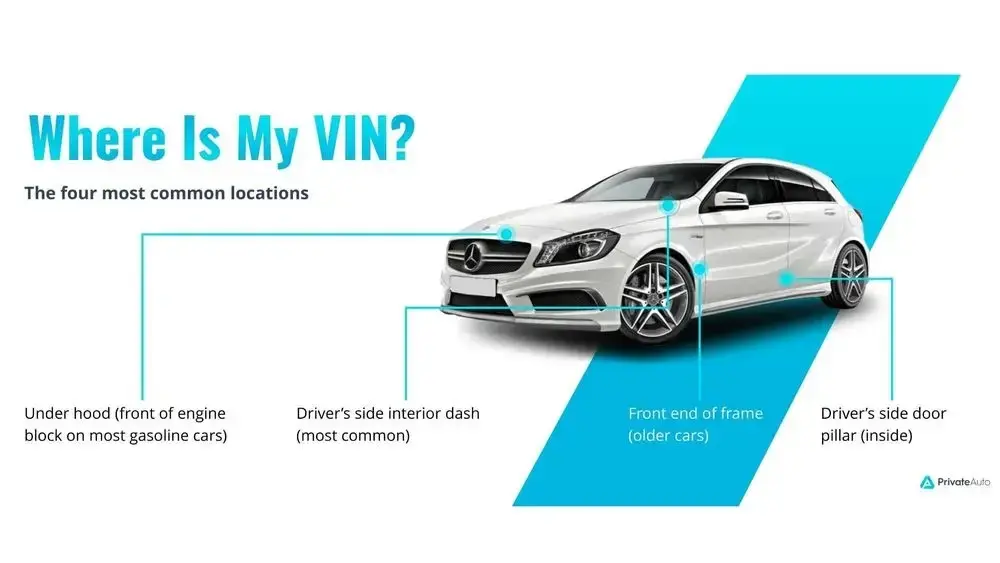Over the years since VINs were implemented in the 1950s, automakers have placed them in different locations on the vehicle.
Since 1981, all vehicles have the VIN embossed on a plate mounted to the dashboard. It’s positioned far forward on the driver’s side so that it’s visible from outside, looking through the windshield.
The VIN can also be found on several additional locations in most vehicles, as well as in certain types of paperwork (your car’s title and insurance documents, for example). You can even locate the car’s VIN number by searching the car’s history reports online. Let’s get into the details.
How do I find the VIN for cars made 1954-1968?
Finding the VIN for 1954-1968 Model Years
Automakers in the United States started using VIN numbers in 1954. Each manufacturer had its own system. They placed the VIN in different places, such as the following:
- On the steering column inside the engine compartment
- Engraved into the car frame
- On the engine firewall
- Near the spare tire
- On the dashboard below the glove box
- On the driver’s side door jamb
As you can imagine, finding the VIN was a challenge without any standardization of placement.

How do the VIN for cars made 1969-present?
Standardizing the VIN, 1969-present
In 1969 the federal government mandated vehicle manufacturers to emboss a VIN number on every vehicle. It required that the VIN be visible from outside the car near the left pillar of the windshield.
Now the International Standards Organization (ISO) sets the standard for creating a VIN for on-road vehicles worldwide.
Rules for VIN Length
Where to locate the VIN?
Where Can I Locate My VIN on the Car?
You can locate the VIN far forward on the driver’s side dashboard, looking through the windshield.
Other places where the VIN may appear on some cars:
- driver’s side door
- chassis
- front of the engine block
- trunk
- radiator support frame
Locating the VIN with the Car Absent
If your car isn’t close by and you need to know your vehicle identification number, you should be able to find the VIN using other methods.
- Search in your vehicle registration
- Look at your vehicle title
- Check your insurance card
- Look at your bill of sale from when you bought the car (included in your PrivateAuto app when you buy through PrivateAuto)
- Ask your mechanic
Title and Registration
A vehicle’s VIN is listed on the Certificate of Title and registration papers. Since the VIN is unique, it matches the vehicle title and registration to a particular car.
Note that the VIN can sometimes be entered on the title incorrectly, so be sure to doublecheck it when buying a used car.
Insurance
Your VIN is also used on your auto insurance policy.
- When you register your car, your state’s Department of Motor Vehicles (or equivalent governmental body) will check that the VIN on your insurance card matches the VIN on your car.
- When you buy a used car, the insurance company checks to see if it’s been declared a total loss. A totaled car that’s been repaired poses some safety risks. Most companies won’t insure them.
Maintenance Shops
You should be able to get the VIN by calling your mechanic. When you take in your car for service or repairs, the tech or mechanic records your VIN into a database.
The mechanic also refers to the VIN to match the correct parts to your vehicle.
Records of your visits to an auto shop appear on a vehicle history report such as AutoCheck.
How Is a VIN used?
How Is a VIN Used?
Your vehicle’s identification number is used to notify you of any issues or safety recalls with your car.
The National Highway Traffic Safety Administration (NHTSA) requires car manufacturers to issue a recall when there’s a safety problem with any of their vehicles.
When a safety recall is issued, you should receive a notification in the mail if your VIN is implicated in a safety issue.
A law enforcement officer might look at a car’s VIN for any of the following reasons.
- To verify it matches the car’s registration
- If a license plate search returns a different car
- To identify an abandoned car without license plates
- To ID a car damaged in an accident, especially if the license plate is illegible
NMVTIS
The US Department of Justice created the National Motor Vehicle Title Information System (NMVTIS) to combat car theft and fraud. Title washed and stolen cars sometimes have had the VIN altered.
- Car cloning. The criminal replaces the VIN plate with a forged plate bearing the VIN of another car. He then registers the car in another state.
- Title washing. When a car is declared a total loss in an insurance claim, it gets a branded title. The fraudster registers in a state that doesn’t have a record of the branded title.
- If the criminal tries to register in another state, the NMVTIS returns “VIN already in use.”
Car History Reports
A car’s history report can tell you a lot about a vehicle’s past. For example, a car history report from AutoCheck, a PrivateAuto trusted partner, can reveal:
- Open recalls
- Accidents
- Flood damage
- Fire damage
- Title liens
- Reported stolen
- Total loss
- Odometer rollback or not actual miles
- Rental, taxi, lease, or government use
- Salvage title
- Structural or frame damage
- Maintenance and repair history
A vehicle identification number has 3 sections:
- World Manufacturer Indicator (WMI)
- Vehicle Descriptor Section (VDS)
- Vehicle Identifier Section (VIS)
World Manufacturer Indicator
The first 3 characters of a VIN number make up the WMI, which indicates the country or region where the car was made. VINs beginning with numbers 1 to 5 were built in North America.
- USA: 1, 4, or 5
- Canada: 2
- Mexico: 3
In some countries, the second character represents the manufacturer.
- Ford: F
- General Motors: G
- Toyota: T
For other countries, the first 2 characters represent the country. Depending on the country, the third digit may represent the automaker, or it may denote a category of vehicles.
The Society of Automotive Engineers (SAE) assigns the WMI to each automaker.
Vehicle Descriptor Section
Positions 4 to 9 of a VIN are the vehicle descriptor section (VDS). This may include info like the model, body style, and drivetrain. Each carmaker has its own system for the VDS.
A lot of manufacturers use the 8th position as an engine descriptor when a model comes with different engine sizes.
Catching Errors with Check Digits
North American auto manufacturers use the 9th position to detect input errors. It’s known as a check digit. When you plug the other 16 characters into a mathematical formula, they return the check digit.
Incidentally, you can also find check digits in many other codes.
- Universal Product Codes (UPC)
- International Standard Book Numbers (ISBN)
- Bank Routing Numbers
Algorithms in computer data entry systems use the digit to check for entry errors.
- Single-digit errors: 1 instead of 2, R instead of T
- Transposition: 1CG instead of 1GC
- Phonetic: “eighteen” instead of “eighty”
The 10th to 17th positions identify a specific car.
Automakers in every country use position 10 to indicate the year model. Some makers, such as General Motors and Chrysler, used letters to encode the year. Beginning with “A” to represent 1980, each letter of the alphabet represented the year models until 2000. In 2001 they began using the last digit of the year to identify the year. For example, 1 for 2001, 2 for 2002, and so on. In 2010, they returned to using letters to represent the year.
For cars made in North America and China, the 11th position is the plant code. Each maker has its own set of plant codes.
The remaining positions indicate the production number, which is different for each automobile.
How to find VIN online for free?
How to Research Car History Online with the VIN
If you have a vehicle’s VIN, you can use the VIN to look up all sorts of info on the car. When shopping for a used car, it’s not a bad idea to get a snapshot of the car’s condition. Here are some free resources for VIN lookup.
1. The National Insurance Crime Bureau VinCheck tool will reveal if a car is stolen or has a branded title.
2. The federal government recall website has a VIN lookup to find safety recalls. It only shows open recalls.
3. Driving-Tests.org has a VIN lookup tool that returns the car’s information and specifications.
4. VinFreecheck.com shows the status of flood records, salvage or lemon title, and previous owners. To get accident reports and other vital car history information, you have to upgrade to a paid report.

PrivateAuto for Easy Used Car Transactions
PrivateAuto makes it easy to buy or sell a used car. Most other sites cater to dealers. PrivateAuto deals exclusively with private buyers and sellers.
Our tech-driven solution makes the entire transaction process easy.
- List your car for free until it’s sold.
- Free printable window brochure so you can advertise on the road.
- Verify driver’s license, email, and phone numbers of both buyers and sellers—helps avoid scams.
- No need to share your personal info with strangers. All communication occurs within the app.
- Schedule test drives and inspections with our in-app appointment tool.
- E-sign a state-specific bill of sale right in the PrivateAuto mobile app.
- Integrated banking allows instantaneous funds transfer any time of day, every day of the year.
- Buyers can apply for financing right within the PrivateAuto app.
Common FAQ About VINs
What is a VIN?
The vehicle identification number, or VIN, is a unique code that identifies an automobile.
It’s a car’s ID number. No two cars have the same VIN.
What does a VIN look like?
The vehicle identification number is a series of letters and numbers. Since 1981, there are 17 characters.
To avoid confusion, VINs do not have the following letters:
– I
– O
– Q
Where are VINs usually located?
On cars made before 1969, you’ll find the VIN on common locations such as the driver’s side door jamb, steering column, and the dashboard below the glovebox.
Cars made after 1969 have the VIN on the driver’s side dashboard. It’s visible from outside the car looking through the windshield.
How long is a VIN?
Vehicle identification numbers on cars before 1980 contain 11 characters or less.
Since 1981, VINs contain 17 characters.
How many VIN locations are there on a car?
VIN numbers are found on three main locations on a vehicle:
– engine block
– driver’s side dashboard, visible from the outside
– driver’s side door jamb
Many cars also have the VIN stamped on the chassis.
How can I find my VIN number without my car?
You can find your car’s VIN on documents such as:
– car title
– vehicle registration
– insurance card
Can I find my VIN number online?
You may be able to find your VIN by logging into your auto insurance account and getting it from your insurance policy.
What was the first car to have a VIN?
The 1953 Chevrolet Corvette was the first car with a VIN number. It was stamped on a metal plate and mounted to the driver’s side doorpost.
